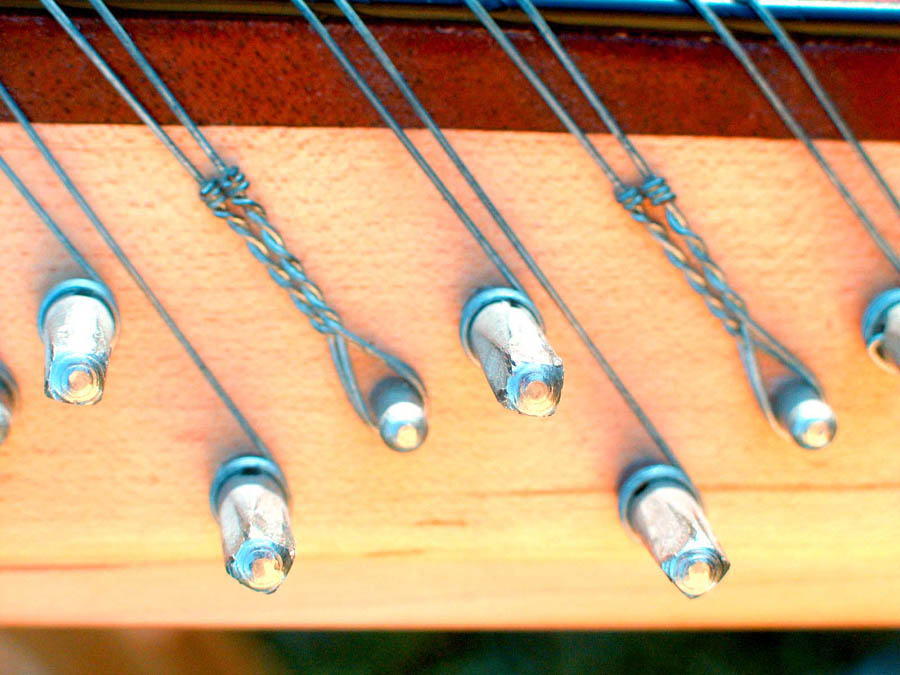
Here are a few suggestions based on my own experience with getting started on hammered dulcimer. Of course you’ll want to do your own research, and there is plenty of information available elsewhere on the web. But basically all you need is a hammered dulcimer (including a set of hammers and a tuning wrench — these are usually provided with the instrument), an electronic tuner, a stand to hold the instrument while you play, and some instruction books or videos.
Hammered Dulcimers
These come in different sizes. The basic (smallest) size is a 12/11, which means that there are 12 pairs of strings passing over the treble bridge and 11 pairs of strings passing over the bass bridge. This will be plenty to get you started and will be the most portable and least expensive. If you already play another musical instrument you may want to start with a 15/14 or a 16/15. If you find that you really love playing the hammered dulcimer, you will most likely upgrade to these bigger sizes at some point.
Most hammered dulcimers have a “stacked diatonic” tuning arrangement, which means that you’ll have the notes from the major scale (do, re, mi, fa, so, la, ti, do) from each of several keys, depending on the size of the instrument. Some hammered dulcimers are known as “chromatic”, which means that small satellite bridges have been added here and there to provide extra notes that would otherwise be missing. The chromatic dulcimers are usually at the high end of the price range.
Another important difference in hammered dulcimers is the amount of sustain. The Master Works hammered dulcimers have a relatively long sustain, which is great for full-sounding slow-to-medium tempo pieces (e.g., new age, classical, Celtic). Folks who like to play very fast or with a band (contra dance music) tend to prefer instruments with less sustain. Some hammered dulcimer builders deliberately strive for very short sustain for this reason. For me, I find that I prefer the warm rich tone (lots of sustain) of my Master Works hammered dulcimer, but everybody is different so you’ll want to explore a bit before deciding.
Here are a couple of web sites that talk a bit about how to choose a hammered dulcimer:
- Dulcimer Crossing – “How to Choose a Hammered Dulcimer”
- House of Musical Traditions – “How to Choose a Hammered Dulcimer” (by Karen Ashbrook)
So where do you buy them?
Two of the bigger hammered dulcimer manufacturers are Master Works and Dusty Strings. Other notable makers include James Jones, Jerry Read Smith, Nicholas Blanton, Rick Thum, Cloud Nine, David Lindsey and others. This is only a partial list of hammered dulcimer builders.
Hammers
Many hammered dulcimer players try a lot of different types of hammers and end up owning a bunch of ’em. I use hammers made by Bob Bedard and by Jill Weimer. Most of the hammered dulcimer builders can also provide hammers. In fact, the hammers I use the most are the very light-weight custom double-sided hammers offered by Master Works.
Electronic Tuners
You will definitely need to have an electronic tuner in order to keep all those strings in tune. Make sure it is a chromatic tuner. The one I have is a Korg CA-30, which works well and is reasonably priced. You can buy tuners from Elderly Instruments and possibly your local music store. My Master Works 16/15c holds its tuning pretty well so I really only have to tune once every couple of weeks (except in the summer when the house humidity and temperature are fluctuating a lot).
Stands
You will eventually need a stand. There are several types available, including some designed for playing while sitting down, some for playing while standing up, and others that are fully adjustable for either sitting or standing. You can get these from Master Works, but there are many other sources as well if you look around a bit.
Instruction Books and Videotapes
I bought John McCutcheon’s hammered dulcimer instruction videotape and it really helped me get a feel for how the instrument is tuned and played. He also teaches some nice tunes. You can buy instruction videotapes from Elderly Instruments or Homespun Tapes. There is a lot of instructional information available for hammered dulcimer. I discuss this in a little more detail at my Instruction books & video’s I’ve used post.
Hammered Dulcimer CDs
You may want to get some hammered dulcimer CDs for inspiration and to get a feel for what sounds you can or should be making. I talk a bit about recordings in my post titled My favorite hammered dulcimer CDs post.
Dulcimer Players News
An excellent resource is the quarterly publication Dulcimer Players News, published by Dan and Angie Landrum. Their website also contains lots of information that will help connect you to other players and information.
Everything Dulcimer
The Everything Dulcimer website also has lo